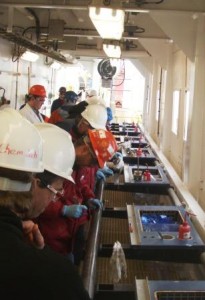‘Core is on the floor’ is the what we hear through the intercom system on the ship, every time when a new piece of sediment floor comes up from the seafloor. What happens after the announcement is a highly streamlined sequence of steps. First the IODP technicians go out on the catwalk (see picture), where they put the core on racks, label it, and cut it in pieces.

From there it goes inside the ship and is left alone for some hours to equilibrate. Then it gets put through a series of so-called track systems, where the physical properties of the sediment are measured. After this, the core is split into two halves – a working half and an archive half. The archive half goes to the sedimentologists, who take pictures of it and describe what type of sediment we found, what colour it has, and what the likely depositional environment was. The working half is used by the palaeomagnetists to measure the magnetic field, which helps us to figure out the age of the core. A complimentary way to find out about the age is to look at the palaeontology in the core (diatoms, radiolarian, dynoflagellates, foraminifera, nannofossil). This is done by another group of people on the ship. They prepare slides and then look at them through the microscope. Finally we, the geochemists, take a sample for determining the amount of carbonate in the core, as well as the elemental composition of the sediment. All this sampling happens on the ‘sampling table’ (see picture). Afterwards the cores are wrapped and stored away.

We are currently drilling our last Site for this expedition. We are recovering a very nice looking record of the more recent past of Antarctica (i.e., the past few million years). Our last attempt to go to the shelf failed yesterday, as the ice is moving in for the winter. Hence the only thing left to do is to drill a bit further offshore. Soon we will start wrapping up all our analyses, finalize the reports we have to write, and pack things away for our return to shore. It has been a long cruise, but I could still stay out for longer. It is simply amazing how much cool science you can get done on the Joides Resolution with all its analytical capabilities, the drilling crew, the IODP technician, and thirty scientist, focusing on one single goal: to make this expedition a scientific success. And we succeeded big time!